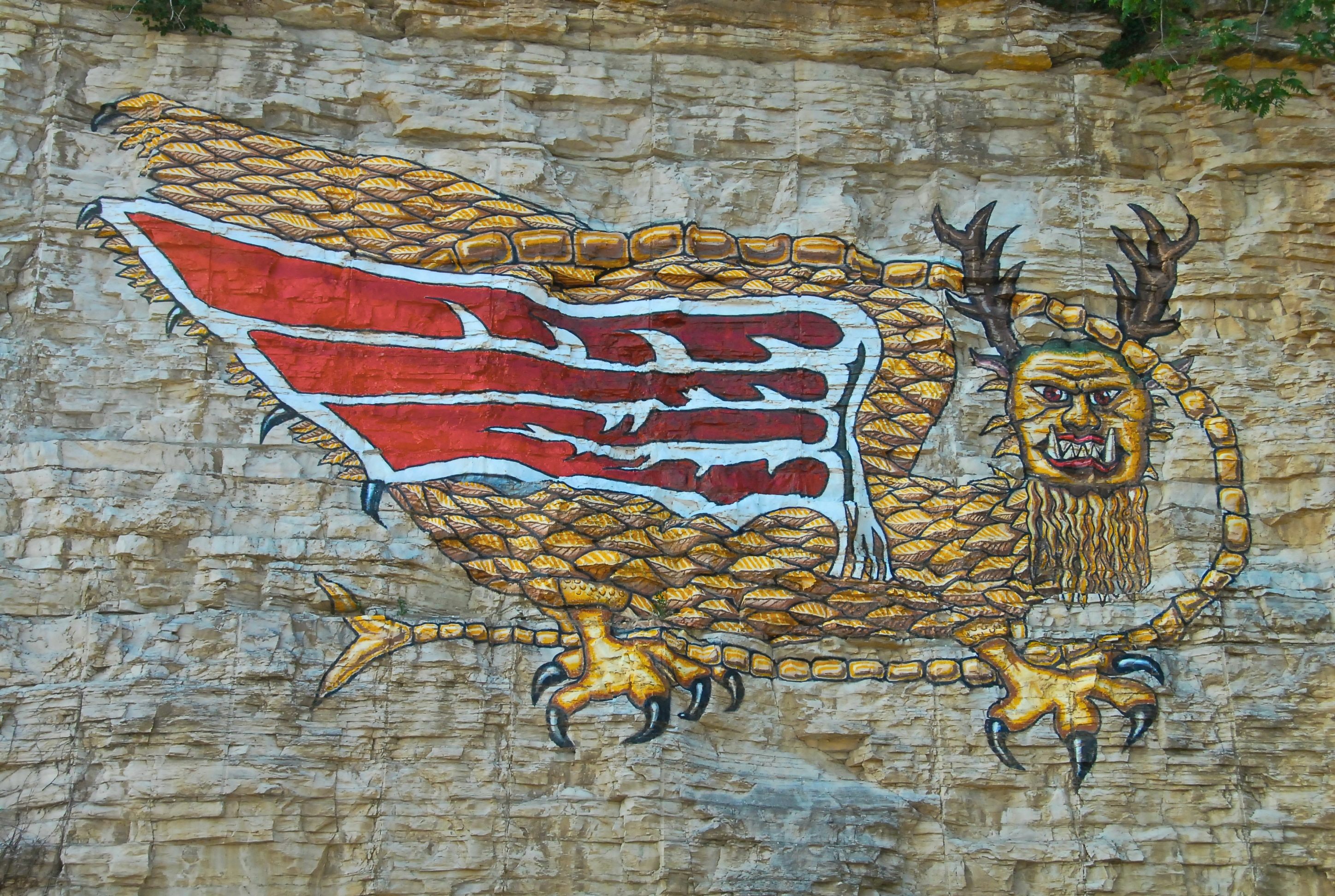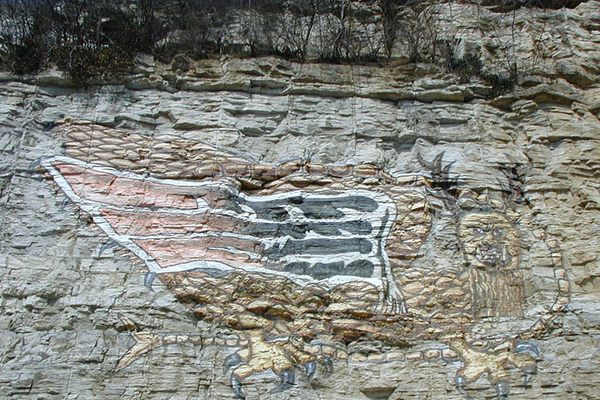The Mythic Child-Stealing Thunderbirds of Illinois
 A recreation of the Piasa Thunderbird, first seen in the late 17th century by European explorers near Alton, Il. (Image: Burfalcy/Wiki Commons/CC BY SA 3.0)
A recreation of the Piasa Thunderbird, first seen in the late 17th century by European explorers near Alton, Il. (Image: Burfalcy/Wiki Commons/CC BY SA 3.0)
This story was sponsored by the fine folks of Enjoy Illinois.
The evening of July 25, 1977 was just like any other hot summer evening for the Lowe family of Lawndale, Illinois. The smell of sizzling beef and grilled vegetables permeated the air as the adults kicked back on lawn chairs, and the kids tussled on the family’s expansive yard outside.
The following is Ruth Lowe’s harrowing eyewitness account of a particularly frightening avian encounter, as written by Jerry D. Coleman of Cryptozoology.com
At approximately 8:10 p.m., the Lowes were cleaning up after their al fresco dinner, the kids still playing outside. And that’s when it happened.
Ruth, the matriarch of the Lowe clan, was cleaning up in the kitchen where she couldn’t see her children. She heard a piercing scream, and knew it was none other than her 10-year old son, Marlon.
When she ran outside to see what the commotion was, she was stunned. Two massive birds, flying in a tight wingtip to wingtip formation were chasing her son, Marlon, pecking and clawing at his shoulders. As Ruth ran to Marlon’s aid, the larger of the two birds sunk their claws into his shirt, fully lifting the 56 pound boy off the ground.
But the birds were no match for a defensive mother. Ruth kept attacking the bird, and it dropped her now terrified son to the ground - after carrying him a distance of over 35 feet.
When the Lowes went to the police, they were laughed out of the precinct. One of the cops allegedly said to Ruth (over the guffaws of his fellow officers), “Now let me get this straight. A giant bird attacked your nephew?”
In her statement to the police, Ruth described the bird as such,
“It had a white ring around its half foot long neck. The rest of the body was very black. The bird’s bill was six inches in length and hooked at the end. The claws on the feet were arranged with three front, one in the back. Each wing, less the body, was four feet at the very least. The entire length of the birds body, from beak to tail feather was approximately four and one half feet.”
Obviously, as with any eyewitness accounts of cryptids, Ruth and Marlon Lowe’s story was met with a healthy dose of skepticism, and even ridicule. As their story was circulated around the local press, Marlon became known to his schoolmates as “bird boy,” and dead pigeons were tossed onto the Lowe family’s porch.
Had Ruth not come outside at that very moment, she was sure the bird would have carried her son away.
 The California Condor, the largest (and one of the most endangered) birds in North America is thought to be a culprit of thunderbird legends. (Image: Gregory Smith/Flickr)
The California Condor, the largest (and one of the most endangered) birds in North America is thought to be a culprit of thunderbird legends. (Image: Gregory Smith/Flickr)
But there may have been some shred of truth to the Lowe’s story, and that’s where it gets complex. Legends abound in Illinois about mysterious giant birds, dating all the way back to the Cahokia tribe, an advanced and largely urbanized chiefdom on the banks of the Mississippi River that petered out around the 13th century.
The cosmology of the Cahokia tribe is filled with fantastic creatures. Motifs of serpents, dragons, and monstrous birds dot the cliffs around the former Cahokia heartland, serving a religious purpose, and also warning strangers and potential foes that they were entering Cahokia territory.
 Cahokia territory at the confluence of the Illinois and Mississippi Rivers as depicted in an 18th century map of Illinois. (Image: Guillame Delisle/Library of Congress/Public Domain)
Cahokia territory at the confluence of the Illinois and Mississippi Rivers as depicted in an 18th century map of Illinois. (Image: Guillame Delisle/Library of Congress/Public Domain)
The most famous of all these cliff drawings is what’s now known as the Piasa Bird, a massive drawing etched into the limestone cliffs outside of Alton, Illinois. First described in 1673 by the Jesuit missionary Jacques Marquette as he was exploring the area, the image clearly shocked Marquette and his party to the core, as he wrote in his journal:
“We saw upon one of them two painted monsters which at first made Us afraid, and upon Which the boldest savages dare not Long rest their eyes. They are as large As a calf; they have Horns on their heads Like those of a deer, a horrible look, red eyes, a beard Like a tiger’s, a face somewhat like a man’s, a body Covered with scales, and so Long A tail that it winds all around the Body, passing above the head and going back between the legs, ending in a Fish’s tail.”
The original depictions of the bird were described as some sort of hybrid reptilian bird, though in later descriptions the creature becomes more bird-like.
The Cahokia tribe calls these birds “thunderbirds” for the sound they make when they flap their giant wings. Considered to be highly intelligent, these creatures alternated between preying on, and assisting the tribe whenever they pleased.
The thunderbirds figure prominently in the legends of other plains tribes as well, including the Lakota, who believe that the birds embody the Supreme Being that created all living things on Earth.
By the 19th century, the original drawing had been completely destroyed—by weather, and vandalism, though it has been consistently redrawn and carefully maintained since then, based on sketches of the original drawing.
 1869 oil painting of Jacques Marquette by Wilhelm Lamprecht. (Image: Wiki Commons/Public Domain)
1869 oil painting of Jacques Marquette by Wilhelm Lamprecht. (Image: Wiki Commons/Public Domain)
In the 1940s, there were a rash of sightings of massive birds in and around Alton, not too far from the Piasa drawing. On April 4th, 1948, an Army Colonel named Walter F. Siegmund saw an astonishing sight, as he was conversing with a local farmer.
“I thought there was something wrong with my eyesight. But it was most definitely a bird, and not a glider or a jet plane. It appeared to be flying Northeast… and from the movements of the object, and its size, I figured it had to be a bird of tremendous size.”
Just a few days later, on April 10th, there was another sighting in the skies above Alton, albeit a brief one. On April 24th, the birds were back, and this time, many people saw them.
Flight instructors at the local airport said the largest of the birds cast a shadow, “as big as a Piper Cub from 500 feet up.” Other eyewitnesses maintained that the birds were as large as small airplanes, and far more humongous than any eagle they had ever seen.
As sudden as they appeared, the birds were gone, never to return—that is, until 1977.
 Turkey vultures, with their massive wingspan, could have been mistaken for the legendary thunderbird. (Image: Dolovis/Wiki Commons/Public Domain)
Turkey vultures, with their massive wingspan, could have been mistaken for the legendary thunderbird. (Image: Dolovis/Wiki Commons/Public Domain)
Credible sightings of the massive thunderbirds have been few and far between since the notorious Lawndale incident. Instead of profiting, the Lowe family was ostracized in their community, pointing to the fact it probably wasn’t a planned hoax.
There are many explanations. Mother Ruth, and son Marlon could have simply panicked. Memory is unreliable and often prone to embellishment. Illinois is home to a significant population of turkey vultures, large carrion-eating birds that could have pegged Marlon as an easy meal, though vultures usually don’t hunt live prey.
The Lawndale bird could theoretically have been an errant condor—these giant birds have wingspans in excess of 10 feet—though the species is endangered and endemic to the West Coast.
 A painted animal skin representation of the Thunderbird from the Great Lakes Region. (Image: Tilman/Wiki Commons/Public Domain)
A painted animal skin representation of the Thunderbird from the Great Lakes Region. (Image: Tilman/Wiki Commons/Public Domain)
The possibilities for explanation are, like with most cryptids, endless. But one thing is for certain: for better or worse, ferocious monsters of the unknown have captured people’s imaginations throughout history. There’s something marvelous about the notion that a giant, man-eating bird of native lore could still be prowling the skies of the Midwest.
For all our scientific advancement, and efforts to catalogue, analyze, and understand the entire world around us, mysteries still do exist.




Follow us on Twitter to get the latest on the world's hidden wonders.
Like us on Facebook to get the latest on the world's hidden wonders.
Follow us on Twitter Like us on Facebook